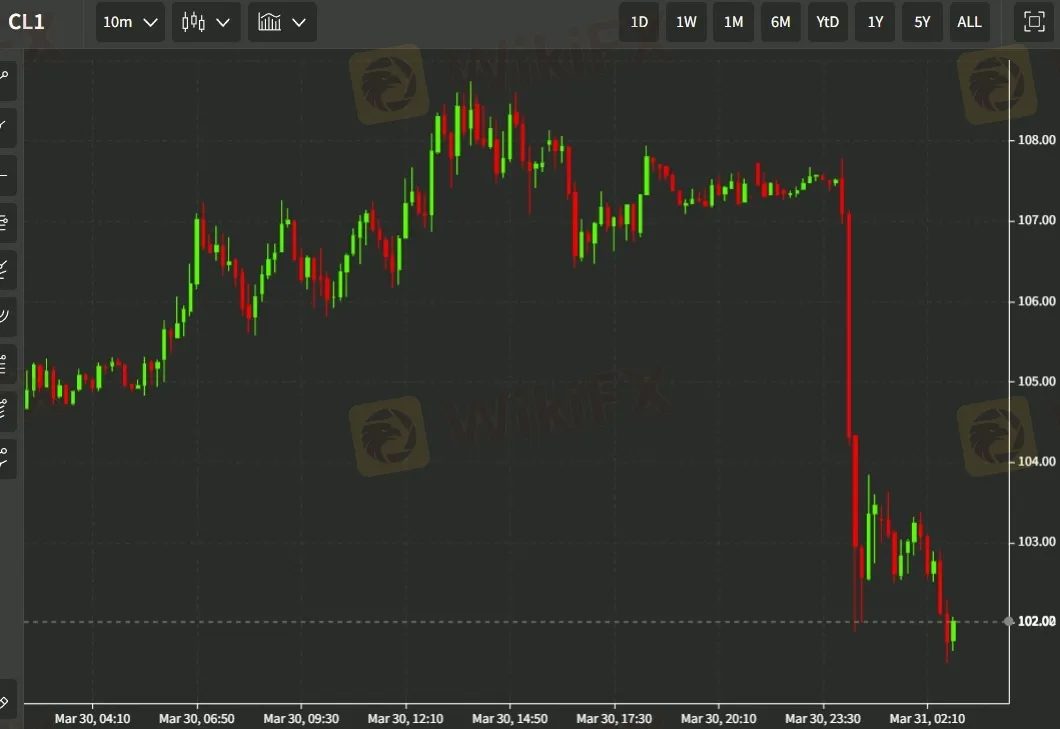简体中文
繁體中文
English
Pусский
日本語
ภาษาไทย
Tiếng Việt
Bahasa Indonesia
Español
हिन्दी
Filippiiniläinen
Français
Deutsch
Português
Türkçe
한국어
العربية
ForexLive Asia FX news roundup: Biden Considers Drawing 180 Million Barrels From the US Oil Reserve
abstrak:On Thursday, March 31, US Vice President Joe Biden will discuss initiatives to reduce gasoline costs. One policy option is to reduce the United States' oil reserves by 180 million barrels. That surprising piece of news broke during the Asian timezone.
On Thursday, March 31, US President Biden will talk about efforts to cut fuel prices. One policy option is to pull down the US oil reserves by 180 million barrels. That shocking news item broke within the Asian timezone.
Initially, it was reported that Biden was considering a 1 million barrel per day pull that would last for months. Given that the US consumes around 20 million barrels of oil per day, adding 1 million barrels to supply would make a marginal change in the price (lower). The 180 million barrel draw was noted while the news was being discussed. At one million dollars each day, this equates to six months of supplies from the Strategic Reserve. I made a post on some of the figures,
that the SPR presently stores around 560 million barrels, therefore a 180 million pull over six months is entirely possible
Also, keep in mind that the royalty on drilling on federal lands is 12.5 percent, which might be a source of filling for the SPR.
This was the main story of the day, and it resulted in a dramatic decline in oil prices.
Today is also the OPEC+ meeting (no change to current policy is expected).

The official (National Bureau of Statistics) PMIs from China for March were also noteworthy. Manufacturing and non-manufacturing both fell back below the 50 line, indicating contraction. The coronavirus outbreak in China in March was the greatest since the pandemic began in early 2020. The associated lockdowns, which are still in effect in several cities, impacted on economic activity, and this is reflected in the PMIs for the month.
While the oil markets were tumultuous, the currency markets were more calmer than they had been earlier this week.
USD/JPY reached a session high of just over 122.40 and is now back around (above) 122.00 as I write this. EUR/USD has risen somewhat. The cable is a little loose. The AUD and NZD have not changed much.
The USD/CAD has risen in tandem with the reduced oil price anticipated by CAD traders.

Disclaimer:
Ang mga pananaw sa artikulong ito ay kumakatawan lamang sa mga personal na pananaw ng may-akda at hindi bumubuo ng payo sa pamumuhunan para sa platform na ito. Ang platform na ito ay hindi ginagarantiyahan ang kawastuhan, pagkakumpleto at pagiging maagap na impormasyon ng artikulo, o mananagot din para sa anumang pagkawala na sanhi ng paggamit o pag-asa ng impormasyon ng artikulo.
Magbasa pa ng marami

Challenge Yourself: Transform from Novice to Expert
From a forex novice to a trading expert, all it takes is this one opportunity! Join us for the Forex Beginner's Advancement Journey challenge and unlock your potential! Here, if you're a beginner, participating in the event and posting on selected topics will not only deepen your understanding of forex basics and help you advance but also earn you a Learning Encouragement Award. For those with some experience in forex, discussing insights under the event topics will allow you to exchange experiences and share techniques with like-minded peers, while also having the chance to win a Perspective Sharing Award! Come challenge yourself and break through the limits of forex trading together!

Sa likod ng Orfinex Prime Brokerage: Isang kaso ng pagsalangsang at negligencia
Orfinex Prime: Mga Allegasyon ng Negligencia at Paglabas | Ang mga problema ng mga kliyente ay nagpapahayag ng mga hindi ligtas na pamamaraan sa pagbebenta, malinaw na presensya sa Dubai, at mga alalahanin ng pagsalangsang. Gumawa ng mga aksyon para sa proteksyon ng mga mamimili.

I-claim ang Iyong 50% Welcome Bonus hanggang $5000!
Bukas sa Parehong Bago at Existing na Customer!

The pound, gilts and renewables: the winners and losers under Britain’s future PM
The race to be the next leader of Britain’s ruling-Conservative Party and the country’s prime minister is into its final leg, with the September outcome likely to shape the fortunes of sterling, gilts and UK stocks in coming months.
Broker ng WikiFX
Exchange Rate






